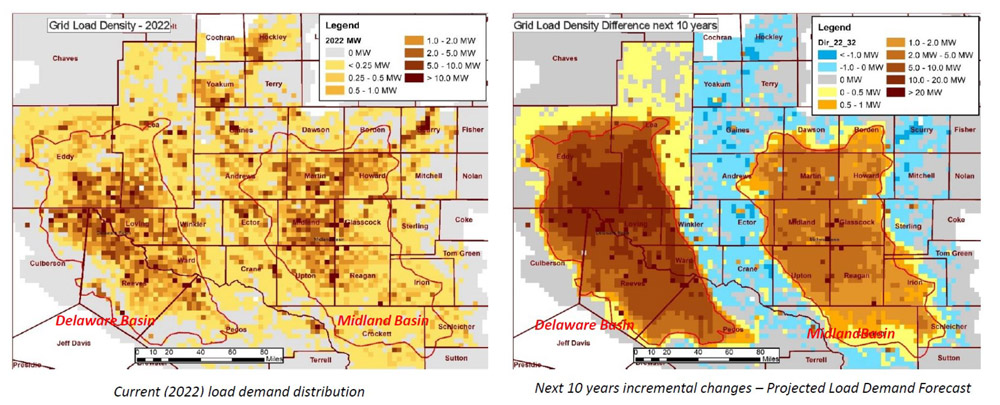
TULSA, Okla. — SPP is considering a 765-kV solution and several 500-kV proposals in its Permian Basin footprint in Texas and New Mexico, its first dabble with extra high voltage (EHV) transmission lines.
Staff have proposed a 300-mile, 765-kV transmission line in New Mexico that will address “extreme” forecast load growth beyond its next two Integrated Transmission Planning (ITP) portfolios. They say it’s part of a proactive approach to get ahead of the region’s growth.
“It’s kind of the big one we’re going to look at,” SPP planning engineer Nick Parker told stakeholders during the Markets and Operations Policy Committee’s July meeting.
Growing electrification of oil and gas activity fuels much of the region’s load growth, although large industrial and data facilities also are contributors. SPP forecasts the Permian’s drilling load in New Mexico to increase by 5.3 GW in 2032. Southwestern Public Service (SPS), the incumbent utility for the region, says its load projects have grown by more than 2,750 MW since the 2023 ITP.
SPP staff said load growth will continue to aggravate issues in an already stressed area of the system and that solutions must address conditions beyond the 2024 ITP due to expected rate of growth.
The 765-kV solution offers other technological and operational advantages. The line’s capacity is nearly three times that of a double-circuit 345-kV line and its cost per MW-mile is less than one-third the cost per MW-mile of 345 facilities, SPP says. Because 765-kV lines use the highest voltage available in the nation, their load is less than lower-voltage lines and they can carry power over longer distances.
“We expect these loads to continue to grow. They’re still coming, and we know that electrification is still coming,” Parker said. “We think it’s just the more proactive approach to go ahead and move forward with the beginning of a 765-transmission system to ensure we can deliver to this area.”
Staff also are considering about 525 miles of 500-kV projects in the same area. They said with anticipated load growth beyond the 2024 and 2025 ITP studies, “a more robust solution” is required to address voltage and power delivery issues in southern New Mexico.
ERCOT staff has projected the SPS projects will cost about $750 million, or almost as much as the 2022 and 2023 ITP portfolios. The entire portfolio could end up costing between $2 billion and $3.5 billion. The costs are conceptual in that they are more “rough estimates” until SPP receives study-level estimates.
“This portfolio is the largest that we’ve ever had in an annual cycle. It is reflective of load changes,” engineering vice president Casey Cathey said, noting the last ITP cycle’s load forecast exceeding two-year-out models in just one year.
“We recognize that there are a number of projects in our queue that probably don’t really need to be in our queue,” he added. “We also recognize there are a number of projects that need to stay, and they need to interconnect.”
ERCOT faces similar challenges addressing the Permian’s explosive growth. In a report filed with Texas regulators, the grid operator said transmission operators expect oil and gas load to peak at 11.96 GW in 2030 and 14.71 GW in 2038. It expects an additional 12 GW of data center and other non-petroleum load by 2030, with the combined total amounting to about a third of the system’s current summer peak (55718).
Based on those forecasts, ERCOT projects a total cost of between $12.95 billion and $15.32 billion for the transmission facilities to meet the coming load. The ISO sees EHV lines as part of the solution, pointing to their “generally known” benefits over 345-kV counterparts: reducing losses for long-distance transportation, increasing short circuit strength and improving voltage stability.
“ERCOT recommends the [Public Utility Commission] give serious consideration to an EHV solution — particularly a 765-kV solution — to meet the forecasted transmission needs,” staff told the PUC.
The commission also is gathering stakeholder input on EHV transmission lines in ERCOT. ERCOT has said in response that incorporating 500-kV and 765-kV lines could reduce or eliminate the need for large underbuilds on the 138-, 115- and 69-kV systems (55249).
“An EHV system would likely remain the backbone of the bulk power system for decades without an increase in voltage,” the grid operator said. It said 500- and 765-kV systems are expected to provide “ample capacity to meet substantial long-term load growth and accommodate large power transfers” and they offer greater flexibility in siting generation resources.



